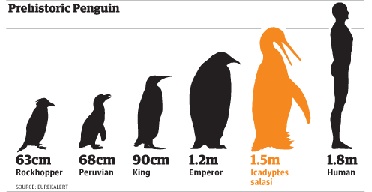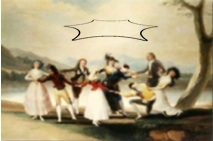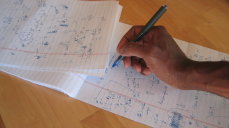Phoenix Mural
I was just reading a bit about the spacecraft Phoenix (a mission to Mars to launch very […] Click to continue reading this post
I was just reading a bit about the spacecraft Phoenix (a mission to Mars to launch very […] Click to continue reading this post
Well, not until September at the earliest, that is. (Oh! That feels so good to have finally been able to use that as a post title!)
 What am I talking about? NASA’s Dawn mission, of course. Dawn is a spacecraft that will go to the asteroid belt to study more closely the two largest asteroids, Ceres and Vesta. (Image right is an artist’s impression of the spacecraft. credit: William K. Hartmann, Courtesy of UCLA) In addition to the mission page linked above, there’s also a nice Wikipedia article about it here.
What am I talking about? NASA’s Dawn mission, of course. Dawn is a spacecraft that will go to the asteroid belt to study more closely the two largest asteroids, Ceres and Vesta. (Image right is an artist’s impression of the spacecraft. credit: William K. Hartmann, Courtesy of UCLA) In addition to the mission page linked above, there’s also a nice Wikipedia article about it here.
Last Thursday was to be the launch, but there were problems due to weather (mostly) – you don’t want to be fueling the tanks of the launch vehicle when there is high risk of lightning, as there was that day. There’s more about the matters on the NASA site, and also and Amara’s post on Scientific Blogging.
Actually, her post there is extremely informative about the goals of the mission, and […] Click to continue reading this post

What is this? The story behind this is just hilarious! I laughed out loud for a good while. […] Click to continue reading this post
So I went out to get a new kettle a few days ago. I’ve now given up on a rather lovely design by the company Chantal that I’ve been using for many years since on two models in succession (or is it three?) the same flaw has revealed itself – the plastic parts of the Hohner whistling lid began to loosen gradually (probably from too much heat up the sides, which may be my fault) and then you eventually end up with a non-fitting non-whistling lid.
I began to assess other kettle designs, and in doing so found myself thinking idly about a number of physics issues. One of the main ones was energy. If I got a smaller kettle (the one I had before had a capacity of 1.8 quarts, and I was considering ones as big as 2 quarts and ones as small as 1.5 quarts), which I was leaning heavily toward, it would probably encourage me to save energy and not boil so much water. On the other hand, maybe that’s really silly, since I might just be putting the same amount of water into the kettle anyway… I’d never fill either up all the way in any case. But if I put the same amount of water into both kettles, would the smaller one end up using less energy anyway as I don’t have to heat up the extra air in the chamber, or does that not matter…? It’s not that simple since the chamber is not sealed. Hot air (and later, steam) is escaping all the time. Well, this is all complicated by the fact that the smaller kettle has less of its base in contact with flame, so I’d have to turn down the flame, and heat it for longer on a lower flame than with the larger kettle… would that make a difference? Perhaps a smaller chamber at lower flame means slower steam escape velocity, and so a quieter whistle. Not good if you’re prone to forgetting that you’ve put the kettle on during an absorbing computation…downright dangerous, in fact!
This was not an entirely serious discussion, you see, but it’s sort of fun sometimes to find these things floating around in one’s head. Physicists (and I imagine, other scientists) have this sort of thing flit through their heads a lot. The key thing -especially as a Theoretical Physicist- is knowing when to engage with one of these problems, and when to ignore them. Is there are clear route to tackling the problem? Is it worth it? Is there something to be learned from solving this problem that might be useful elsewhere? In fact, I was trying to explain this all to a writer friend of mine […] Click to continue reading this post
I noticed that the eleventh edition of the blog carnival Philosophia Naturalis has been posted at Highly Allachthonous. Do follow the link and have a read of the various Physics (and related) posts that have been collected there*. The host Chris Rowan has organized things by distance scale (in powers … Click to continue reading this post
(Title refers to an phrase used in commercials for a chocolate bar that I remember from many years ago: “P-p-pick up a penguin”.)
Anyway: It’s Big. Really big. A recent archeological find of a giant ancestor penguin (Icadyptes salasi) in Peru:

(Comparative graphic from article listed below.)
I learned from Jonathan Shock and Sara Tompson about SciTalks. In Jonathan’s words (from a comment on another post):
“There’s now a site where people can link to, review and rate scientific videos online. This is a great step as there are so many wonderful lectures online but currently they’re spread all over the web and it’s always hard to tell the quality and level that a lecture is going to be.”
Jonathan has also done posts about online resources in theoretical high energy physics, including a recent one where he discussed SciTalks a bit more.
 This got me thinking a bit about where we are going with all these resources, how useful they are, and -very importantly- how easy it all is to find, and then to search through. (Imagine there are 10 hour long talks broadly on your favourite topic. Assuming there are no accompanying files, how can you search them to find a specific fact that they might mention, without sitting through ten hours worth of material?) Well, ironically, one of the first things that caught my eye on SciTalks was a rather nice talk by Jennifer Golbeck (given at FermiLab last year) entitled “Social Networks, the Semantic Web, and the Future of Online Scientific Collaborationâ€. She’s quite interesting about this very topic… She describes online collaboration, data sharing, social networks, etc, all in the context of helping us do science (not just physics by the way!). She also illustrates her subject matter -still staying on topic- using examples of data sets from Facebook, Myspace, Friendster, […] Click to continue reading this post
This got me thinking a bit about where we are going with all these resources, how useful they are, and -very importantly- how easy it all is to find, and then to search through. (Imagine there are 10 hour long talks broadly on your favourite topic. Assuming there are no accompanying files, how can you search them to find a specific fact that they might mention, without sitting through ten hours worth of material?) Well, ironically, one of the first things that caught my eye on SciTalks was a rather nice talk by Jennifer Golbeck (given at FermiLab last year) entitled “Social Networks, the Semantic Web, and the Future of Online Scientific Collaborationâ€. She’s quite interesting about this very topic… She describes online collaboration, data sharing, social networks, etc, all in the context of helping us do science (not just physics by the way!). She also illustrates her subject matter -still staying on topic- using examples of data sets from Facebook, Myspace, Friendster, […] Click to continue reading this post
I know nothing about Mr Wizard (Donald Herbert), largely because I grew up elsewhere. Many of you do, however. Even if not*, this (from Rebecca at Skepchicks) is worth pursuing**:
“Ultimately, the point is to flood YouTube with videos of people doing fun and entertaining science experiments. Woo hoo!”
I’ve just noticed that Jacques Distler will be blogging from Strings 2007 (his first post is here). Excellent! I hope that others will be too. If you learn of anyone else who will be blogging from the conference (either physics content or other aspects of the event), do let me … Click to continue reading this post
 The main annual conference in my main field of interest starts today. Strings 2007 is in Madrid, and runs all week. The website is here (while there, have a play with the front page image of the Goya painting – quite entertaining). They promise to update the schedule/speakers page with scans of slides, and video, so you’ll be able to keep track of some of the new developments online. There’s no system for doing this live, or asking questions remotely, so if you want to quiz Ed Witten about his new 83-page monster paper on three dimensional gravity that came out yesterday (just in time for the conference!), or feel the buzz of event-anticipation whenever Witten talks about huge new sets of results, you’ll still have to show up in person.
The main annual conference in my main field of interest starts today. Strings 2007 is in Madrid, and runs all week. The website is here (while there, have a play with the front page image of the Goya painting – quite entertaining). They promise to update the schedule/speakers page with scans of slides, and video, so you’ll be able to keep track of some of the new developments online. There’s no system for doing this live, or asking questions remotely, so if you want to quiz Ed Witten about his new 83-page monster paper on three dimensional gravity that came out yesterday (just in time for the conference!), or feel the buzz of event-anticipation whenever Witten talks about huge new sets of results, you’ll still have to show up in person.
Why am I not there? Well, it would be nice, but there are lots of reasons I’m not going […] Click to continue reading this post
Not long after I told you about the TASI school and the excellent online lecture resource they were rapidly building, I heard* about a school in Utah that might be of interest, especially if you’re interested in the fruitful interface between mathematics […] Click to continue reading this post
 …and then you have days when nothing works. At all. This was not like last Saturday. Despite starting out nice and early with a cup of tea in the sunshine and scribbling away while wrinkling one’s brow. Things got worse and worse through the morning, as I realized that many things I so wanted to be right about the next stage of my computation (which perhaps I’ll tell you about one day) were in fact not going to work. Not even close.
…and then you have days when nothing works. At all. This was not like last Saturday. Despite starting out nice and early with a cup of tea in the sunshine and scribbling away while wrinkling one’s brow. Things got worse and worse through the morning, as I realized that many things I so wanted to be right about the next stage of my computation (which perhaps I’ll tell you about one day) were in fact not going to work. Not even close.
By lunchtime I’d given up, and summarized my thoughts on the research blog for my collaborators. Was probably not the most encouraging reading for them to encounter, but I tried to be as constructive in my deconstruction of our idea as I could. I’m hoping that they -or later, I- might find some useful threads to pick up on from my notes and remarks.
It’s not over yet.
Maybe I should have gone for that hike instead of sitting entirely at home on a […] Click to continue reading this post
You’ll be pleased to know that some of our best people are on it:
 The BBC Radio 4 program Archive Hour was just brilliant on the weekend. Here is the synopsis:
The BBC Radio 4 program Archive Hour was just brilliant on the weekend. Here is the synopsis:
Adam Hart Davies looks at some of the predictions made in the past by scientists, programme-makers and politicians about how future society and technology would develop. He explores some of the moral and ethical dilemmas arising from mankind’s thirst for new inventions, new technologies and new ways of life.
(Image right: Chesley Bonestell painting for a cover of The Magazine of Fantasy & Science Fiction in 1950. See more art from that era at this excellent site.)
It brings to the issue a lot of archival footage of interviews, debates, and other material. There are interviews with many interesting people, including scientists and science fiction writers. The role of science fiction (the really good stuff, not the stuff that’s purely space opera… although sometimes it is hard to know which is which without the benefit of hindsight) is discussed quite a bit too.
There are the usual discussions about mobile phones, communications satellites, and the like, well-known things that were anticipated by writers of fiction, but the programme is much more interesting than that, reflecting upon the impact of various technologies and medical techniques (e.g. heart transplants) and how they were regarded and debated at the time, since they were often seen as either assaults on, or enhancements of (depending upon point of view) our humanity. This discussion is all in aid of reflecting upon us in the present. (Consider carefully the face transplant, for example, and how people react to what that means…)
There’s also very interesting discussion of the moral/ethical responsibility of the […] Click to continue reading this post
 Yes, part of my job is to sit and think about how the universe works. People hear this, and they wonder exactly what that entails. Well, it entails a lot of things – sometimes there’s the grand thoughts and the thought experiments and the like that you hear of from documentaries and books about Einstein and other famous scientists – but more often that not it is grungy nuts and bolts.
Yes, part of my job is to sit and think about how the universe works. People hear this, and they wonder exactly what that entails. Well, it entails a lot of things – sometimes there’s the grand thoughts and the thought experiments and the like that you hear of from documentaries and books about Einstein and other famous scientists – but more often that not it is grungy nuts and bolts.
Take yesterday for example. After a week of working on various calculations and chipping away at improving my understanding of how to approach a certain problem, I decided to take Saturday and be outdoors a bit more…see what it was like outside. You know…. Have an actual Saturday Saturday. (I did not end up being booked to do that TV shoot, by the way, so I had a nice clear day ahead of me.)
What actually transpired was this: […] Click to continue reading this post